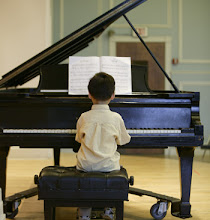We asked some of our faculty members to offer some insights into the methods and motivations behind Settlement's offerings in music, dance and ensemble instruction. Today, in honor of the birthday of Shinichi Suzuki, developer of the Suzuki method, we turn the blog over to Daniel Elyar, faculty member since 2003 and instructor at the Camden and Mary Louise Curtis branches, to learn more about Suzuki and working with the very youngest musicians.
The Suzuki method is a set of instructional techniques for young children, including daily listening, constant repetition, parent responsibility, and loving encouragement, among other elements. Shinichi Suzuki’s basis for developing this method stemmed from
post-WWII Japan;
he desired to create a generation of “noble souls” and help communities build
from the ground up, starting with the youngest. He felt violin was one of the best tools to do this, though not to the
exclusion of other disciplines like piano, flute or even mathematics! He felt that as a child desires to learn
their native language well and does, this “mother-tongue” instinct can be
tapped to create groups of young children who learn many difficult -- but also creative, enlightening, and fun --
skills together. The idea that violin
had to be learned by children in middle school was dismissed; if the children
can talk and listen, they can play and make music.
 | |||
| Elyar (on left in background) and his students in a showcase at Settlement's annual Open House |
This is how I was trained as a young violinist: I
recall playing countless rounds of “Twinkle, Twinkle Little Star” and “Lightly
Row” with groups in venues ranging from concert halls to shopping malls, and each
time I played, the community came together to
celebrate the talents of the youngest and showing the community that playing
together makes them patient, productive, kind to others and creative. After these experiences, it came naturally for me to study the Suzuki method when I went to
Conservatory. As enjoyable as it was as
a small child, I learned to appreciate its value as a method of learning by
teaching it. Knowing the method from the
child’s perspective and the trained teacher’s has given me a wealth of ideas on
how to help the youngest in these communities thrive and blossom.
The ideal of a “three legged stool” is emphasized from the beginning. The legs which support the learning are the pupil, the teacher, and the pupil’s involved parents -- a new concept at the time. Also, the ideal of children thriving when learning together comes through from the very beginning: no young child would excel at a difficult skill if sat in a room with an adult only once a week with no other stimulus.
The ideal of a “three legged stool” is emphasized from the beginning. The legs which support the learning are the pupil, the teacher, and the pupil’s involved parents -- a new concept at the time. Also, the ideal of children thriving when learning together comes through from the very beginning: no young child would excel at a difficult skill if sat in a room with an adult only once a week with no other stimulus.
The child must be immersed in the sounds of music daily and
guided through play and lessons in groups with his or her peers together. Not only do the children learn from the
teacher and the encouragement of the parents but also by witnessing their peers
play on a weekly basis in group classes. Then Suzuki created a graded curriculum of music that progresses step by
step with pieces that enliven the developing musical mind as well as the
fingers -- possibly his most enduring achievement.
 |
| Preparing to face a number of challenges |
The prospective Suzuki student faces a number of
challenges: the violin is a tricky instrument to start on, and the sounds are
possibly the least pleasant of all instruments at the very beginning. The ear, mind and fingers all need to be
developed well with each other for students to excel. Fortunately, the Method gives the pupils a set
of tools with which to face these challenges: a musical curriculum that is
appealing from the very beginning, a structure that encourages participation
and development through weekly lessons and group classes, a way for parents to
be involved and better understand the skills their children are working on,
and, most importantly, especially to Dr. Suzuki himself, gentle encouragement
and love. The discipline of violin
technique is too tricky to face without it.
With this method, my young students love what they do and
develop a fun working relationship with a group of their peers, and I also have
parents who are fully engaged and involved in a music making process. I teach the Suzuki method to help a community grow and
commit itself in the best way possible to its future.



